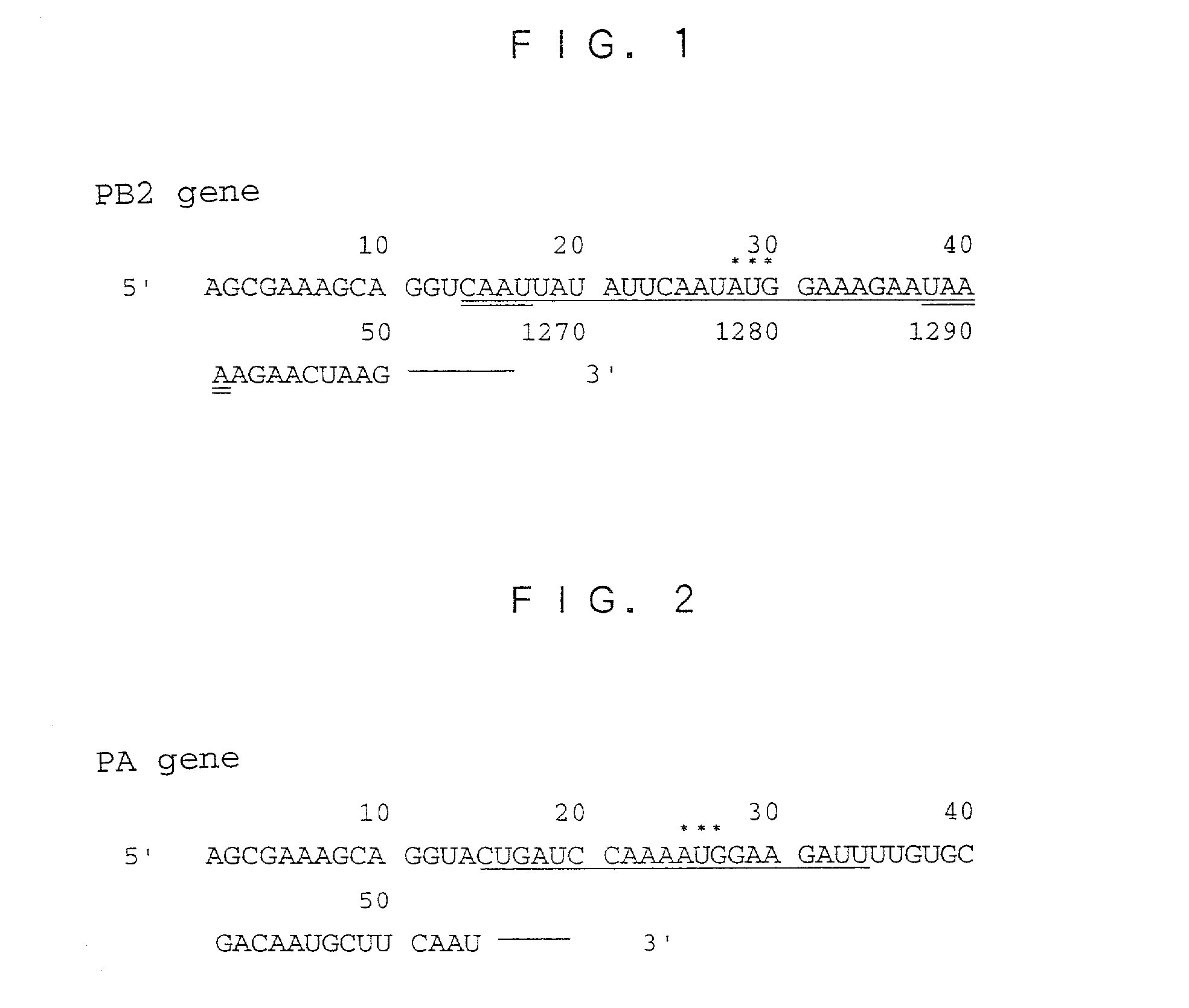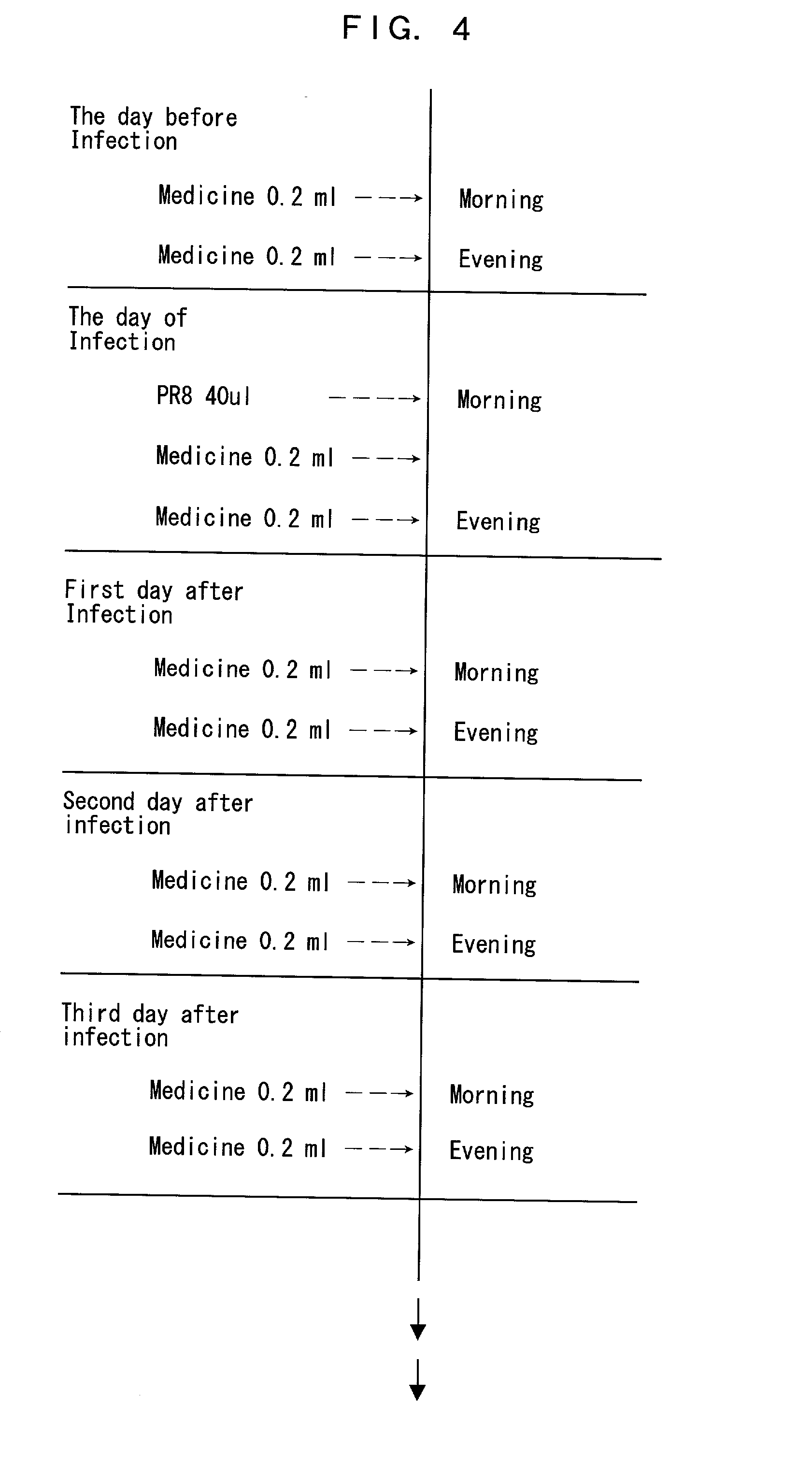Pharmaceutical composition for treating or preventing influenza, and novel oligonucleotide
- Summary
- Abstract
- Description
- Claims
- Application Information
AI Technical Summary
Benefits of technology
Problems solved by technology
Method used
Image
Examples
example 1
Design of Oligonucleotides
[0055] As the target genes for use in the following Examples, the PB2 gene and the PA gene were selected, and the translational initiation regions were selected. The base sequence in the translational initiation region of the PB2 gene is shown in FIG. 1, and the base sequence in the translational initiation region of the PA gene is shown in FIG. 2.
[0056] More particularly, two base sequences were selected from the translational initiation region of the PB2 gene. The first base sequence is the sequence from the 18th to 37th bases underlined in FIG. 1, and composed of 20 bases (the base sequence of SEQ ID NO: 11). The second base sequence is the sequence from the 14th to 41st bases containing each of 4 bases underlined twice in FIG. 1 in addition to the first base sequence upstream and downstream thereof, and composed of 28 bases (the base sequence of SEQ ID NO: 12). As the translational initiation region of the PA gene, the sequence from the 15th to 34th bas...
example 2
Synthesis of oligonucleotides
[0061] Five oligonucleotides designed in Example 1 were synthesized, using an automated DNA synthesizer (Model 392: Applied Biosystems) in accordance with a program for a phosphorothioate type oligonucleotide. That is, oligonucleotides were synthesized in accordance with a phosphoramidite method using a solid phase column (1 .mu.mol scale; Cruachem, United Kingdom) and reagents for DNA synthesis (Cruachem, United Kingdom), and then cut from the column and deprotected in accordance with the conventional method [A. Chollet & E. H. Kawashima, Nucleic Acids Res., 13, 1529 (1985)]. An amount of 1 / 500 (about 4 .mu.g) of each of the resulting oligonucleotides was applied to a 20% polyacrylamide gel electrophoresis containing 7 M urea. The electrophoresis was carried out at a constant voltage of 150 V for 1.5 hours. After the electrophoresis was completed, the gel was stained with methylene blue to confirm that each of the synthesized oligonucleotides had a pred...
example 3
Successive Intravenous Administration of Antisense Oligonucleotides (1)
[0063] Five oligonucleotides prepared in Example 2, i.e., PB2 (20as), PB2 (20ran), PA (20as), PA (20ran), and PB2 (28as), were incubated at room temperature for 20 to 30 minutes in a sterilized phosphate buffered saline (PBS), a Tfx-10 solution in PBS (in an amount such that a dose of Tfx-10 is 5 mg / kg or less), a COATSOME EL-C-01 (NOF Corporation) solution in PBS (in an amount such that a dose of COATSOME EL-C-01 is 20 .mu.mol / kg), and a COATSOME EL-N-01 solution in PBS (in an amount such that a dose of COATSOME EL-N-01 is 20 .mu.mol / kg), and dissolved therein to prepare sample solutions containing the above oligonucleotides at a concentration of 0.2 (w / v) % or 0.4 (w / v) %. The sample solutions were stored in a refrigerator at 4.degree. C., until used for a treatment of test animals (mice).
[0064] Female BALB / c mice (body weight=17 to 20 g; 6 weeks old) were used as the test animals, and divided into test groups....
PUM
| Property | Measurement | Unit |
|---|---|---|
| Fraction | aaaaa | aaaaa |
| Fraction | aaaaa | aaaaa |
| Fraction | aaaaa | aaaaa |
Abstract
Description
Claims
Application Information
 Login to View More
Login to View More - R&D
- Intellectual Property
- Life Sciences
- Materials
- Tech Scout
- Unparalleled Data Quality
- Higher Quality Content
- 60% Fewer Hallucinations
Browse by: Latest US Patents, China's latest patents, Technical Efficacy Thesaurus, Application Domain, Technology Topic, Popular Technical Reports.
© 2025 PatSnap. All rights reserved.Legal|Privacy policy|Modern Slavery Act Transparency Statement|Sitemap|About US| Contact US: help@patsnap.com



